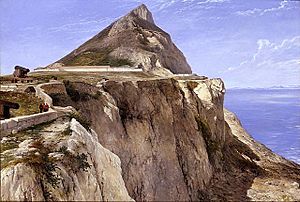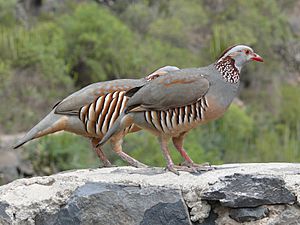Windmill Hill (Gibraltar) facts for kids
Windmill Hill, also known as Windmill Hill Flats, is a flat area of land at the southern tip of Gibraltar. It is one of two main plateaus in this area. Windmill Hill sits just south of the famous Rock of Gibraltar, which drops steeply down to it.
This plateau gently slopes downwards from north to south. Its height changes from about 120 meters (394 feet) at the north end to 90 meters (295 feet) at the south end. Windmill Hill covers an area of about 19 hectares (47 acres). About 6 hectares (15 acres) at its northern end have buildings on them.
Cliffs surround the south and east sides of Windmill Hill. These cliffs lead down to another flat area called Europa Flats, which also has sea cliffs around it. Both plateaus were formed by the ocean wearing away the land over a very long time. Later, the land was pushed upwards by natural forces. Windmill Hill was once the coastline, with waves carving its cliffs. Then, the land rose, and the shoreline moved further out to what is now Europa Flats.
Military history
Windmill Hill has always been important for military defense. It was made stronger with forts in the 1770s. This was part of improvements made by Chief Engineer Colonel William Green. These changes happened before the Great Siege of Gibraltar, a famous battle.
A soldier named John Drinkwater wrote about the siege. He said that Windmill Hill's hidden and hard-to-reach defenses were very strong. He noted they were close to the sea and very important for protecting that area.
During the 1800s, many artillery batteries (places for cannons) were built here. These helped protect the lower defenses on Europa Flats. They could also fire on any enemies trying to land nearby. Some of these batteries included Buffadero Battery and Levant Battery. Because the plateau was flat, it was also easy to move cannons around as needed. At the top of the plateau, the Retrenched Barracks provided housing for soldiers. It also acted as a small fort to stop enemies from reaching the higher parts of the Rock.
Lathbury Barracks was built on the plateau in the early 1960s. The British Army used it until 1991. Now, the Government of Gibraltar owns it. A NATO communications center was also built there in the 1970s. The Royal Gibraltar Regiment has its Buffadero Training Centre nearby. British Army units use this center for different training exercises. This includes practicing fighting in built-up areas in a special mock-up village. The rocky ground and thick bushes in the area are similar to places like Afghanistan. This has made it useful for training British troops for missions there.
How people use Windmill Hill
Windmill Hill is a bit far from the main towns in Gibraltar. However, in the late 1700s, you could still see the ruins of very old Moorish buildings there. These buildings would have been at least 350 years old then.
The Jewish community of Gibraltar created a cemetery on Windmill Hill. It is called the Jews' Gate Cemetery. It was described as being in a "very airy and elevated situation."
In 2010, the Government of Gibraltar opened a prison there called HM Prison Windmill Hill. Building a prison on Windmill Hill was first suggested a long time ago, in 1854. Before that, prisoners were kept in the Moorish Castle. This situation was not good, but it continued until the new prison opened. The Detention Barracks, a military prison, also stood on Windmill Hill for many years. It was taken down in 1962.
In 2009, the government also thought about building a new power station on the old barracks' parade ground. But people worried about how this would affect the area's many different animals and plants. In March 2012, the new government decided not to build the power station there.
Wildlife and caves
Windmill Hill is one of the most important places for wildlife in Gibraltar. It is a Site of Community Importance (SCI) under the European Union's Habitats Directive. Even though the ground seems tough with thin soil over rocks, many different plants grow here. Some of these plants are not found anywhere else in Gibraltar. Examples include Salvia verbenaca (wild clary) and Echium parviflorum (small-flowered bugloss). The middle of Windmill Hill is mostly open with very few plants covering the ground. The edges have low bushes, usually about 0.75 meters (2.5 feet) tall, but some can grow up to 2 meters (6.5 feet).
Windmill Hill is a very important spot for migrating birds. Many birds flying between Europe and Africa stop here. It is often the first place they land in Europe after crossing the Strait of Gibraltar. Gibraltar's national bird, the Barbary partridge (Alectoris barbara), nests in the open areas of the plateau. Bats also hunt for insects here.
Caves and ancient animals
A number of Gibraltar's caves are found under Windmill Hill. The Genista Caves were discovered in the 1860s. Workers were making the military prison bigger when they found partly blocked cracks. When these cracks were dug out, they led to the caves. Captain Frederick Brome explored them, using prisoners to help with the digging. The caves were named after Brome; Genista is the Latin name for broom plants, making it a clever play on his name.
The digging in the caves revealed the bones of many large animals. These animals are now extinct in Gibraltar. They included lynx, leopard, hyena, rhinoceros, and aurochs (a type of wild cattle). It seems they fell through cracks in the ground and could not get out. Sadly, the entrance to the cave was later lost or destroyed. This happened when a large magazine (a building for storing ammunition) was built right over it in the late 1800s.



